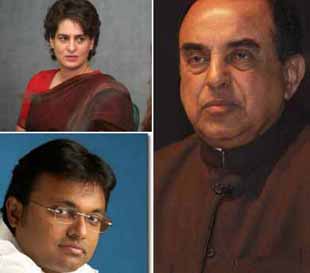New Delhi, Jun 29: The credibility of senior BJP leader Subramanian Swamy, who is considered as one of the most controversial politicians in India, is once again at stake as his allegation against two prominent figures of opposition also proved to be false.
 Priyanka Gandhi and Karti Chidambaram have only one Director Identification Number (DIN) issued to them, Corporate Affairs Ministry has said contradicting the vociferous claim of senior Bharatiya Janata Party (BJP) leader Subramanian Swamy that they possessed multiple numbers.
Priyanka Gandhi and Karti Chidambaram have only one Director Identification Number (DIN) issued to them, Corporate Affairs Ministry has said contradicting the vociferous claim of senior Bharatiya Janata Party (BJP) leader Subramanian Swamy that they possessed multiple numbers.
The Ministry has also said that other DIN applications (online) made by them had "lapsed" or were "rejected" and not allotted to them. "Priyanka Gandhi, wife of Robert Vadra, is holding only one DIN allotted by Ministry. The DIN application was made online and processed by the DIN cell assisted by service provider company under MCA21.
"The valid DIN number... was allotted on her application dated January 10, 2007," Pankaj Srivastava, Assistant Central Public Information Officer, Office of Regional Director, NR, Noida said in an RTI response dated June 17, 2014 to Bhilwara- based RTI activist SS Ranawat.
"No penalty order was passed by this Directorate as the power to impose is vested with Courts under the provisions of the Companies Act, 1956," the reply said in response to a question seeking a copy of any penalty orders imposed on her.
The issue was raised by Subramanian Swamy who had filed complaints against Priyanka Vadra and Karti Chidambaram with the Ministry alleging that the two had multiple DINs, which is not permissible under the Companies Law.
Karti Chidambaram is the son of former Finance Minister P Chidambaram.
In the case of Karti also, the Ministry said in its response that he is "holding only one DIN allotted by the Ministry. The DIN application was made online and processed by the DIN cell assisted by service provider company under MCA21."
"However, the DIN documents and related information are in the nature of personal information and the disclosure of which has no relationship to any public activity or interest or which would cause unwarranted invasion of the privacy of the individuals as prescribed under section 8(1)(j) of the Right to Information Act," it said.





Comments
This news is totally fake. In fact both the persons have DI number more than one. I have sufficient documentary evidences, which PTI ignored for the reasons best known to them.
Add new comment